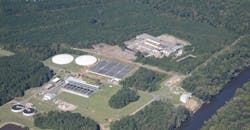Bloom Energy to install 1.5 MW Biogas Fuel Cells for North Carolina Municipal entity
Bloom Energy will install 1.5 MW of solid oxide fuel cells for the Fayetteville Public Works Commission, adjacent to its P.O. Hoffer Water Treatment Facility and near the former Texfi industrial site, which is considered one of the most polluted sites in North Carolina.
The installation will generate renewable energy from multiple biogas streams by combining ambient air with biogas from the Cross Creek Water Reclamation and methane gas from local and neighboring swine farms. It will be among the first of its kind to combine multiple waste gas sources to generate carbon-neutral electricity, sufficient to meet the power requirements of more 1,000 homes.
“This project is an anchor for the broader plan to remediate and establish a Cleanfields Renewable Energy Demonstration Park in the community,” said Elaina Ball, CEO and general manager, Fayetteville PWC
As waste generation increases – possibly by 70% by 2050 – this project will reduce biogas flaring at wastewater and landfill facilities, reduce emissions, improve air quality and help meet North Carolina’s clean energy standards. Waste generated from wastewater treatment and landfills is flared – a used and controlled method to release gas into the atmosphere – contributing to air pollution. Moreover, the project will complement the industrial pollution cleanup in the region and provide an always-on and reliable source of electricity.
“Producing resilient and renewable energy from waste sources is a critical component of decarbonized and sustainable circular economy,” said Chuck Moesta, vice president, gas management, Bloom Energy. “Our waste-to-energy solutions are garnering increasing interest from communities and municipalities. We look forward to bringing this innovative project alive with Fayetteville’s municipal utility, setting an important example for other communities around the U.S. wishing to transition to clean, carbon-neutral energy.”
About the Author
EnergyTech Staff
Rod Walton is senior editor for EnergyTech.com. He has spent 17 years covering the energy industry as a newspaper and trade journalist.
Walton formerly was energy writer and business editor at the Tulsa World. Later, he spent six years covering the electricity power sector for Pennwell and Clarion Events. He joined Endeavor and EnergyTech in November 2021.
He can be reached at [email protected].
EnergyTech is focused on the mission critical and large-scale energy users and their sustainability and resiliency goals. These include the commercial and industrial sectors, as well as the military, universities, data centers and microgrids.
Many large-scale energy users such as Fortune 500 companies, and mission-critical users such as military bases, universities, healthcare facilities, public safety and data centers, shifting their energy priorities to reach net-zero carbon goals within the coming decades. These include plans for renewable energy power purchase agreements, but also on-site resiliency projects such as microgrids, combined heat and power, rooftop solar, energy storage, digitalization and building efficiency upgrades.
